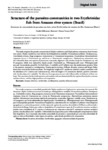Por favor, use este identificador para citar o enlazar este ítem:
http://www.alice.cnptia.embrapa.br/alice/handle/doc/1019179Registro completo de metadatos
| Campo DC | Valor | Lengua/Idioma |
|---|---|---|
| dc.contributor.author | ALCÂNTARA, N. M. | pt_BR |
| dc.contributor.author | TAVARES-DIAS, M. | pt_BR |
| dc.date.accessioned | 2015-07-02T11:11:11Z | pt_BR |
| dc.date.available | 2015-07-02T11:11:11Z | pt_BR |
| dc.date.created | 2015-07-02 | pt_BR |
| dc.date.issued | 2015 | pt_BR |
| dc.identifier.citation | Revista Brasileira de Parasitologia Veterinária, Jaboticabal, v. 24, n. 2, p. 183-190, abr./jun. 2015. | pt_BR |
| dc.identifier.issn | 1984-2961 | pt_BR |
| dc.identifier.uri | http://www.alice.cnptia.embrapa.br/alice/handle/doc/1019179 | pt_BR |
| dc.description | This study compared the parasite communities of Hoplias malabaricus and Hoplerythrinus unitaeniatus from Amazon river system. Hoplias malabaricus were infected by Ichthyophthirius multifiliis, Piscinoodinium pillulare, Tetrahymena sp., Urocleidoides eremitus, Braga patagonica, metacercariae of Clinostomum marginatum, Procamallanus (Spirocamallanus) inopinatus, larvae of Contracaecum sp. and larvae of Nomimoscolex matogrossensis. Hoplerythrinus unitaeniatus were also infected by these same species of protozoans, nematodes, digeneans and cestodes, except for Tetrahymena sp. and B. patagonica, which were replaced by Argulus pestifer, Urocleidoides sp., Whittingtonocotyle caetei, Whittingtonocotyle jeju and Gorytocephalus spectabilis. For both hosts, I. multifiliis and P. pillulare were the predominant parasites. Most of the parasites presented an overdispersion. Parasite species richness, Brillouin diversity, evenness and Berger-Parker dominance were similar for the two hosts. The length and weight of H. malabaricus showed a positive correlation with the abundance of U. eremitus and Contracaecum sp., while the weight of H. unitaeniatus showed a positive correlation with the abundance of I. multifiliis. The diversity of ectoparasites seemed to be influenced by the behavior of these two hosts. This was shown by the similar parasite communities and was characterized by low species diversity, low evenness and low richness, and by a high prevalence of ectoparasites. | pt_BR |
| dc.language.iso | eng | eng |
| dc.rights | openAccess | eng |
| dc.subject | Diversidade | pt_BR |
| dc.subject | Agregação | pt_BR |
| dc.subject | Infracomunidade de parasito | pt_BR |
| dc.subject | Diversity | pt_BR |
| dc.subject | Overdispersion | pt_BR |
| dc.subject | Parasite infracommunity | pt_BR |
| dc.subject | Amazon | pt_BR |
| dc.title | Structure of the parasites communities in two Erythrinidae fish from Amazon river system (Brazil). | pt_BR |
| dc.type | Artigo de periódico | pt_BR |
| dc.date.updated | 2017-03-14T11:11:11Z | pt_BR |
| dc.subject.nalthesaurus | Erythrinidae | pt_BR |
| riaa.ainfo.id | 1019179 | pt_BR |
| riaa.ainfo.lastupdate | 2017-03-14 | pt_BR |
| dc.contributor.institution | MARCOS TAVARES-DIAS, CPAF-AP. | pt_BR |
| Aparece en las colecciones: | Artigo em periódico indexado (CPAF-AP)  | |
Ficheros en este ítem:
| Fichero | Descripción | Tamaño | Formato | |
|---|---|---|---|---|
| CPAFAP2015Structureoftheparasites.pdf | 278,01 kB | Adobe PDF |  Visualizar/Abrir |









